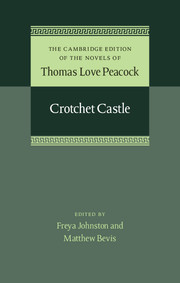Book contents
- Frontmatter
- Contents
- List of Illustrations
- General Editor’s Preface
- Acknowledgements
- Chronology
- List of Abbreviations
- Introduction
- Crotchet Castle
- Appendix A Peacock’s Preface of 1837
- Appendix B Holograph Fragment of Chapter 4 (c. 1830)
- Appendix C Holograph Fragment of Chapter 5 (c. 1830)
- Appendix D Holograph Manuscript of ‘Touchandgo’ (Watermark 1827)
- Appendix E Holograph Manuscript of ‘Touchandgo’ (Watermark 1828)
- Appendix F Holograph Fragment of Chapter 16 (c. 1830)
- Appendix G ‘The Fate of a Broom: An Anticipation’ (1831, 1837)
- Note on the Text
- Emendations and Variants
- Ambiguous Line-End Hyphenations
- Explanatory Notes
- Select Bibliography
Introduction
Published online by Cambridge University Press: 30 June 2022
- Frontmatter
- Contents
- List of Illustrations
- General Editor’s Preface
- Acknowledgements
- Chronology
- List of Abbreviations
- Introduction
- Crotchet Castle
- Appendix A Peacock’s Preface of 1837
- Appendix B Holograph Fragment of Chapter 4 (c. 1830)
- Appendix C Holograph Fragment of Chapter 5 (c. 1830)
- Appendix D Holograph Manuscript of ‘Touchandgo’ (Watermark 1827)
- Appendix E Holograph Manuscript of ‘Touchandgo’ (Watermark 1828)
- Appendix F Holograph Fragment of Chapter 16 (c. 1830)
- Appendix G ‘The Fate of a Broom: An Anticipation’ (1831, 1837)
- Note on the Text
- Emendations and Variants
- Ambiguous Line-End Hyphenations
- Explanatory Notes
- Select Bibliography
Summary
GENESIS AND COMPOSITION
On 24 January 1829, ‘Touchandgo’, Peacock's boisterous satirical poem on rogue bankers, appeared in the Globe and Traveller. At around the same time, he was asked ‘to look into the whole question’ of steam navigation; that request yielded a ‘Memorandum respecting the Application of Steam Navigation to the internal and external Communications of India’, dated September 1829. By the end of 1830, these divergent strains of topical commentary had united to produce Crotchet Castle. Navigation, steam, bureaucracy, paper money and ‘all the recognised modes of accumulation on the windy side of the law’ (Chapter 1) shaped Peacock's sixth novel. They began, perhaps, to combine after dinner, as various ideas are said to mingle in the Reverend Doctor Folliott's mind at the beginning of Chapter 8: ‘fish and wine, Greek and political economy, the Sleeping Venus he had left behind, and poor dear Mrs. Folliott … passed, as in a camera obscura, over the tablets of his imagination’.
‘Touchandgo’ was sparked by the flight on 27 December 1828 of Rowland Stephenson (1782–1856) – politician, art collector and defaulting Lombard Street banker – and his assistant, John Henry Lloyd. Thanks to a number of unsecured advances, authorized by Lloyd, the bank of Remington, Stephenson and Coleman, and Stephenson himself, were ruined. A reward was offered, in vain, for his capture. With Lloyd, he fled to Savannah, Georgia, reportedly cashing the securities he had stolen and acquiring a brace of loaded pistols from a pawnbroker. The episode was so scandalous (the escape of ‘the nefarious banker’ and his clerk, via the Devonshire fishing village of Clovelly, was included in a book of illustrations published four years later) that one contemporary reviewer, glossing Crotchet Castle, felt it wholly unnecessary to elaborate: ‘We need not tell the reader what period or event of the last seven years is pointed to in the following extract.’ James Fenimore Cooper recalled people asking him in Italy and Switzerland why Stephenson had been permitted to remain in America, after landing in Georgia and being removed by bounty hunters to New York: ‘I understood pretty distinctly’, wrote Cooper, ‘that there were reports current that the Americans were so desirous of obtaining rich emigrants, that they had rescued a criminal in order to reap the benefit of his gold!’
- Type
- Chapter
- Information
- Crotchet Castle , pp. lix - cxxiiPublisher: Cambridge University PressPrint publication year: 2016



